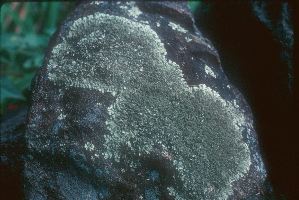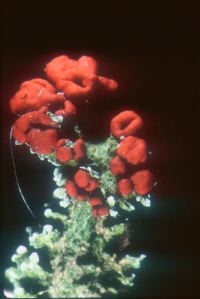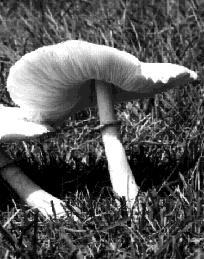Some 100,000 species of fungi have been identified, but the true number is probably larger.
Ascomycetes produce two kinds of spores:
- asexual spores called conidia
- ascospores produced following sexual reproduction. Four or eight ascospores develop inside a saclike ascus (the group is commonly called sac fungi).
Some notable examples:
- Saccharomyces cerevisiae one of the budding yeasts. It ferments sugar to ethanol and carbon dioxide [Discussion] and thus is used
- to make alcoholic beverages like beer and wine
- to make ethanol for industrial use
- in baking (it is often called baker's yeast). Here, it is the carbon dioxide that is wanted (to make bread and cakes "rise" and have a spongy texture).
 Yeast is also used
Yeast is also used
- Neurospora crassa, another favorite "model" organism in the laboratory.
- The fungal partner in most lichens is an ascomycete.
- Powdery mildews that attack ornamental plants
- The chestnut blight, which in a few decades killed almost all of the mature American chestnut trees in the Appalachians of North America.
- The Dutch elm disease, which has killed many of the American elms in the United States.
- Pneumocystis jirovecii, which is a major cause of illness in immunosuppressed people, e.g., patients with AIDS.
- The truffle and the morel, both highly-prized food delicacies. The photo (courtesy of the French Embassy Press & Information Division) shows a farmer from the Périgord (in southwestern France) admiring a truffle. Truffles establish a symbiotic relationship with the roots of such trees as oaks.

- Lichens are fungi that live in a symbiotic association with an autotrophic green alga or cyanobacterium (the "photobiont") or — in some cases — both. A few species of lichen use a dinoflagellate as their photobiont.
- The fungal partner (the "mycobiont") in most lichens (98% of them) is an ascomycete. Zygomycetes make up the remainder.
- The relationship is often characterized as mutualistic; that is, both partners benefit. But recent evidence (e.g. in British soldier) suggests that while the fungus is dependent on its autotrophic partner, the photobiont is often perfectly content to live alone.
- Recently many lichens have been found to harbor a third partner, a single-celled basidiomycete. Its function remains to be discovered.
- Lichens secrete a variety of unusual chemicals; some of these probably assist in the breakdown of rock substrates like the one shown here.
The lower image is of the colorful lichen called British soldier.

- The fungus is Cladonia cristatella, an ascomycete. Its name is the name given to the lichen.
- The photobiont is Trebouxia erici, a green alga. It is found in many other lichens as well, and also can be found growing independently.
- The algal cells eventually are killed by the fungus, but are continuously replaced by new ones.
- So the relationship in this lichen is one of controlled parasitism rather than mutualism.
- The red cap produces the spores of the fungus, but these alone cannot form new lichens.
- Other structures (e.g., soredia), containing both partners, are needed to disperse the lichen to new locations.
- Some lichens release only fungal spores. These mycobionts depend for their continued survival on finding an acceptable photobiont released from other lichens.
Phylogenetic trees, based on both ribosomal RNA genes and many protein-coding genes, as well as fossils indicate that lichens have been present on the earth for at least 600 million years.
Today about 14,000 species of fungi form lichens.
| Lichens are extremely sensitive to air pollution. One of the best contemporary examples of evolutionary adaptation is the change in coloration of the peppered moth as the lichens in its habitat declined because of air pollution and then returned when air quality controls were put in place. Link to an illustrated discussion. |
Some modern fungi (e.g., Penicillium chrysogenum, the source of the antibiotic penicillin) appear to have evolved from lichen-forming ancestors — abandoning their original symbiotic way of life.
Basidiomycetes include mushrooms, shelf fungi, puffballs, rusts, and smuts. They are dispersed by spores borne at the tips of basidia (giving rise to the name for the group).

Mushrooms are masses of interwoven hyphae growing up from the main mass of the mycelium growing underground. The basidia develop on the undersides and release their spores (four from each basidium) into the air.
A single mycelium may expand outward year after year as its hyphae grow into new terrain. In some species, mushrooms are sent up once a year at the periphery producing a circle known since medieval times as a "fairy ring".
Some notable basidiomycetes:
- Armillaria bulbosa. A single specimen in northern Michigan (USA) was found to have spread over 37 acres (15 hectares) of the forest floor. RFLP analysis of samples taken from many different locations within this area showed that all the samples were from a single clone. Assuming the normal rate of vegetative growth for this species, it must have taken 1500 years to spread to that size.
- the cultivated, edible mushroom that finds its way into pizza, soups, etc.
- Amanita muscaria. Forms a beautiful mushroom but deadly when eaten.
- Smuts. Parasites of important crops like wheat, oats, and rye.
- Rusts. Some, such as
- wheat black stem rust (Puccinia graminis) and
- white pine blister rust
are serious pests. Both have complicated life cycles during which they pass through a second plant host (barberry plants for wheat black stem rust, gooseberries or wild currants for the white pine blister rust).
All the fungi assigned to this group (which probably does not represent a single clade) form spores in a sporangium.
Some notable examples:
- the bread mold, Rhizopus stolonifera
- Rhizopus oryzae, used to make sake, the rice wine of Asia. Can also infect humans, especially if they are immunosuppressed (e.g., AIDS patients, transplant recipients).
- Another species of Rhizopus is used in the commercial production of glucocorticoids.
- Many mycorrhizal fungi belong to this group.
Chytrids (Phylum Chytridiomycota)
This small group (~1000 species) is thought to be the most primitive of the fungi. Unlike all the other fungi, its members produce flagellated gametes (for sexual reproduction) and flagellated zoospores (for asexual reproduction). They are mostly aquatic.
Two species are responsible for the recent worldwide decline in amphibian populations (frogs, toads, and salamanders).
16 July 2022


 Yeast is also used
Yeast is also used


